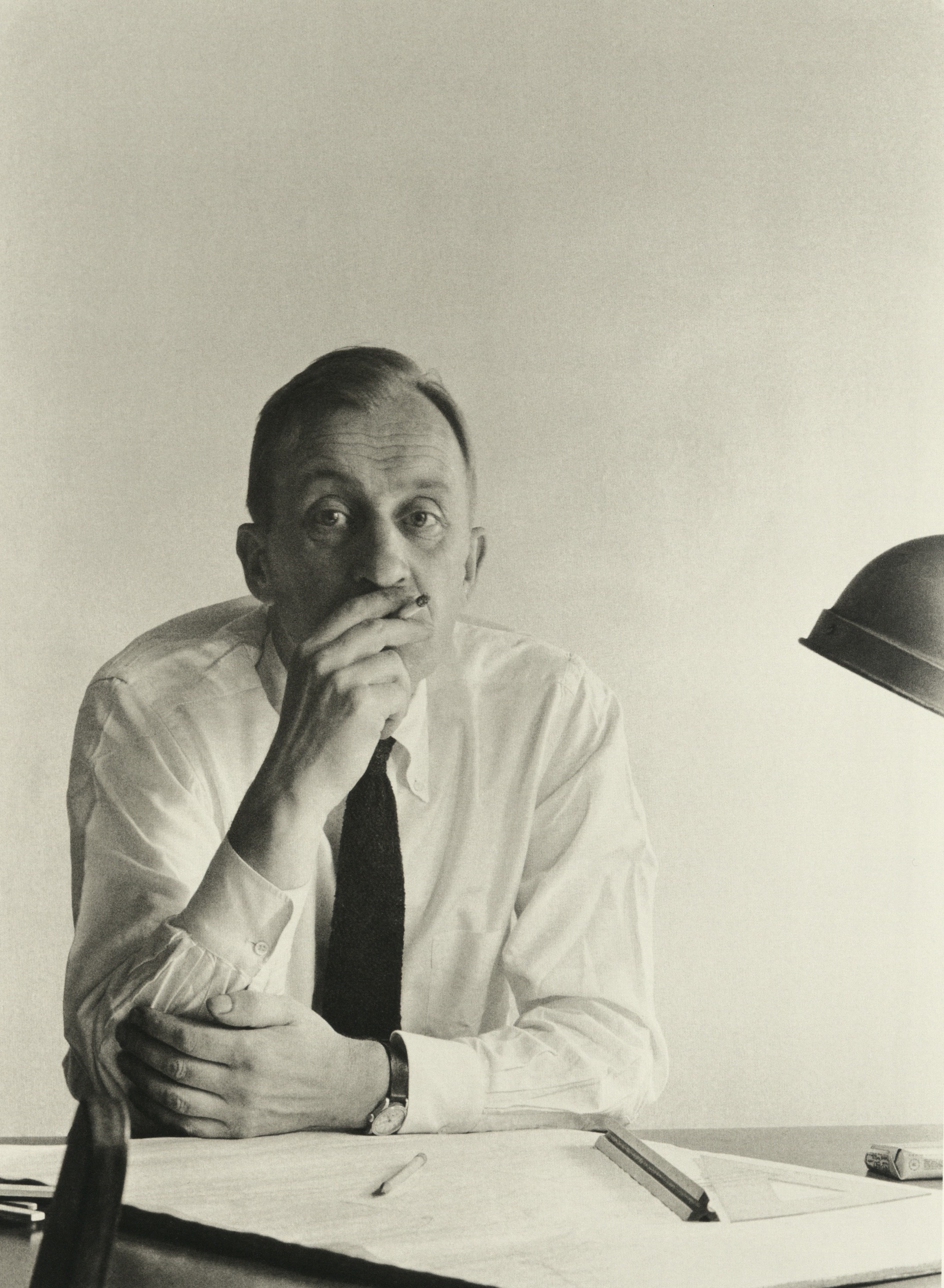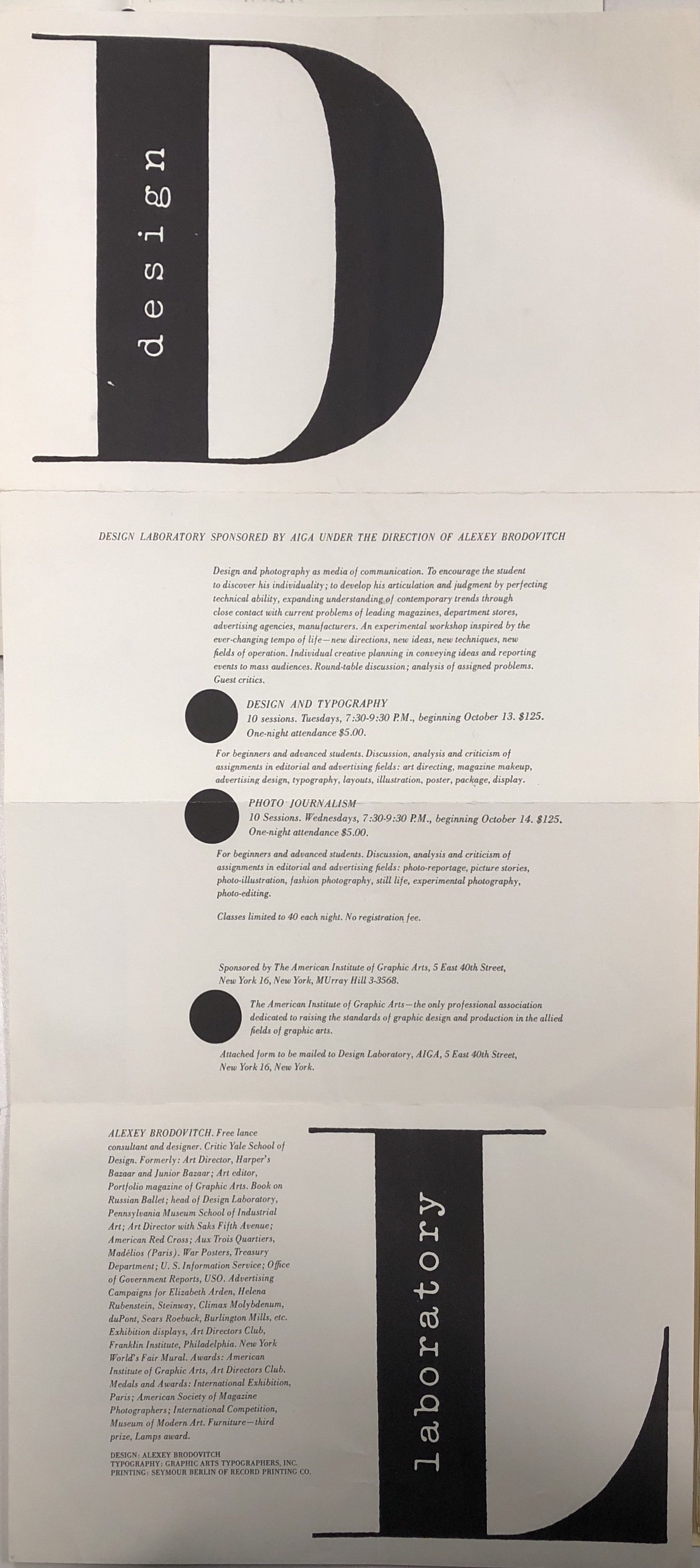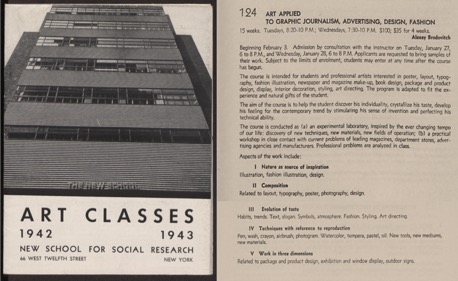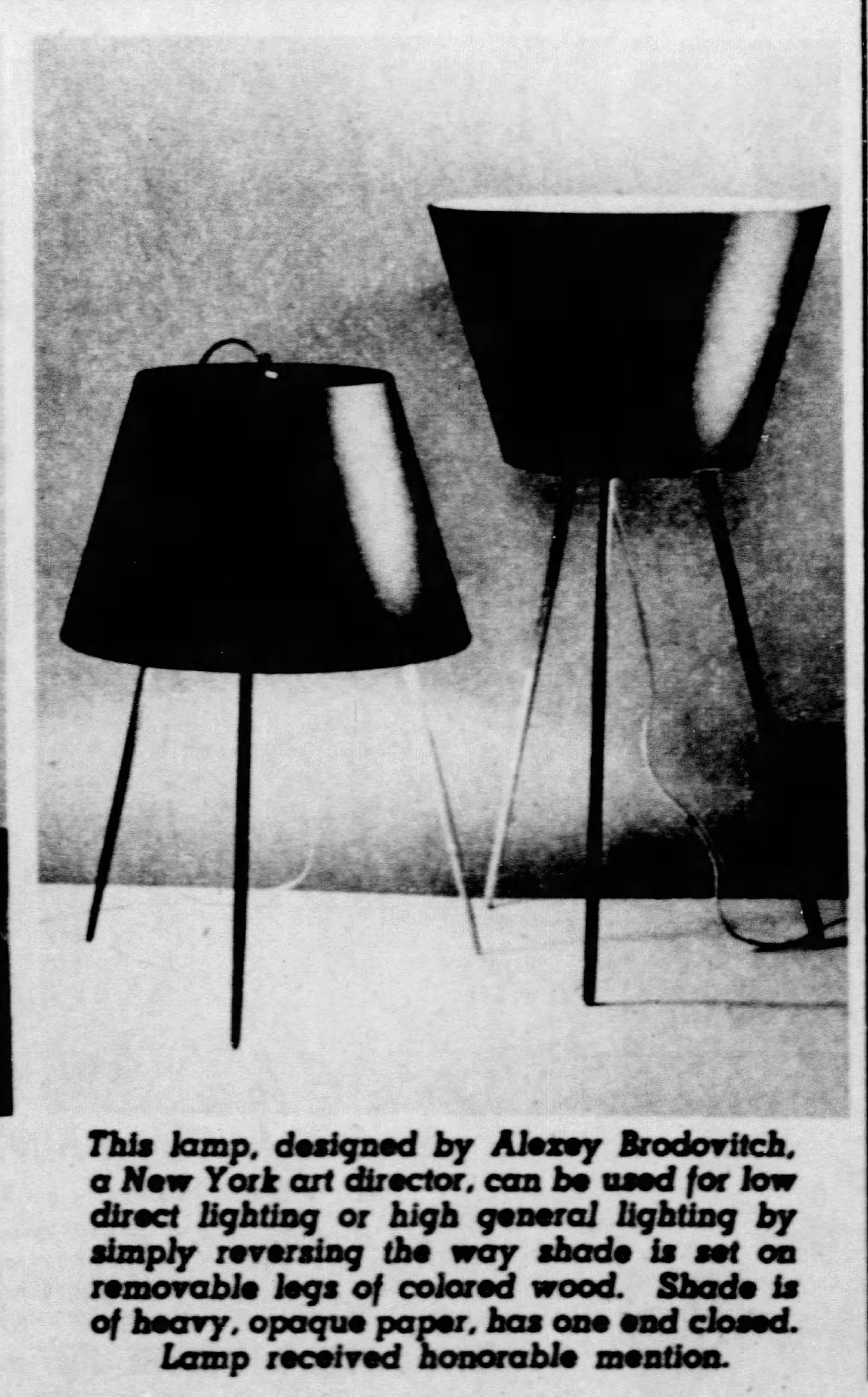Archive
https://archive.metromod.net/viewer.p/69/2948/object/5138-9603672
Archive
Alexey Brodovitch
- Alexey
- Brodovitch
Alexei Brodowitsch, Alexis Brodovitch
- 01-05-1898
- Ogolichi (BLR)
- 15-04-1971
- Le Thor (FR)
- PhotographerArt DirectorGraphic Designer
Alexey Brodovitch was a Belarus-born émigré graphic artist, art director and photographer who, from 1933, worked in New York for Harper’s Bazaar magazine and at the New School for Social Research.
Word Count: 31

Hermann Landshoff, Der Grafikdesigner, Fotograf und Art Director Alexey Brodovitch in seiner Wohnung, 1942–45, New York (© bpk / Münchner Stadtmuseum, Sammlung Fotografie / Archiv Landshoff). 
Announcement of Alexey Brodovitch “Advertising Design” course at the Pennsylvanian Museum School for Industrial Art (The Philadelphia Inquirer, 24 September 1933, p. 30). 
Announcement of the Design Laboratory by Alexey Brodovitch at the New School of Social Research (© Clara Meyer Papers. Brodovitch, Alexey, 1949-1959, Box: 1, Folder: 35. The New School Archives). 
Announcement of "Art Applied to Graphic Journalism, Advertising, Design, Fashion" course by Alexey Brodovitch, published in New School Bulletin. Art Classes, 1942/43, p. 11 (© New School course catalog collection, NS-05-01-01. The New School Archives). 
Cover of Ballet by Alexey Brodovitch (J.J. Augustin, 1945). 
Design of a lamp by Alexey Brodovitch (St. Louis Post Dispatch, 25 March 1951, p. 103). Alexey Brodovitch. Der erste Art Director, edited by Stefanie Häberli-Bachmann, exh. cat. Museum für Gestaltung Zürich, Zürich, 2021.
Displaced Visions. Émigré Photographers of the 20th Century, edited by Nissan N. Perez, exh. cat. The Israel Museum, Jerusalem, 2013.
Dogramaci, Burcu, and Helene Roth. “Fotografie als Mittler im Exil: Fotojournalismus bei Picture Post in London und Fototheorie und -praxis an der New School for Social Research in New York.” Vermittler*innen zwischen den Kulturen, special issue of Zeitschrift für Museum und Bildung, vol. 86–87, 2019, pp. 13–44.
Gallagher, Jenna Gabrial. “Alexey Brodovitch: 1934–1958.” Harpers Bazaar, 1 June 2007. Accessed 29 March 2021.
Gilbert, George. The Illustrated Worldwide Who’s Who of Jews in Photography. G. Gilbert, 1996.
Grundberg, Andy. Brodovitch (Masters of American Design). H.N. Abrams, 1989.
Modern Look. Photography and the American Magazine, edited by Mason Klein, exh. cat. Jewish Museum, New York, 2020.
Morris, John Godfrey. Get the Picture. A Personal History of Photojournalism. University of Chicago Press, 2002.
New York. Capital of Photography, edited by Max Kozloff, exh. cat. Jewish Museum, New York, 2002.
Purcell, Kerry William. Alexey Brodovitch, Phaidon Press, 2002.
Word Count: 174
Berlin, Germany (1920–1923); Paris, France (1923–1930); Philadelphia, US (1930–1933); New York, US (1934–1967); Le Thor, France (1967–1971).
304 East 66th Street, Lennox Hill, New York City (residence, 1933–1950s); 315 East 57th Street, Sutton Place, New York City (residence,1950s–1967); 572 Madison Avenue, Midtown Manhattan, New York City (workplace Harper's Bazaar, Hearst Company, 1934–1958).
- New York
- Helene Roth. "Alexey Brodovitch." METROMOD Archive, 2021, https://archive.metromod.net/viewer.p/69/2948/object/5138-9603672, last modified: 08-11-2022.
-
Hermann LandshoffPhotographerNew York
Besides outdoor fashion shots, Hermann Landshoff was a portrait and street photographer. During his time in New York, he captured the cultural, artistic and intellectual émigré scene as well as his photographer colleagues.
Word Count: 33
Kurt SafranskiPicture AgentFounding MemberTeacherCartoonistPublisherIllustratorNew YorkKurt Safranski was one of the founding members of the Black Star photo agency, a teacher at the New School for Social Research and the author of photojournalistic articles and books.
Word Count: 31
Josef BreitenbachPhotographerNew YorkOn arriving in New York in 1941, the German photographer Josef Breitenbach tried to restart as a portrait, street and experimental photographer, as well as a teacher of photo-history and techniques.
Word Count: 30
Andreas FeiningerPhotographerWriterEditorNew YorkAndreas Feininger, was a German émigré photographer who arrived in New York with his wife Wysse Feininger in 1939. He started a lifelong career exploring the city's streets, working as a photojournalist and writing a large number of photography manuals.
Word Count: 39
Ruth BernhardPhotographerNew YorkRuth Bernhard was a German émigré photographer who lived in New York from the 1920s to the 1940s. Beside her series on female nudes, her place in the photography network, as well as in the New York queer scene, is unknown and understudied.
Word Count: 43
Lisette ModelPhotographerNew YorkLisette Model was an Austrian-born photographer who lived in New York with her husband Evsa Model after emigrating from France. Her street photographs capturing the curiosities of everyday life quickly caught the interest of museums and magazines.
Word Count: 37
Charles LeirensPhotographerMusicianMusicologistNew YorkCharles Leirens was a Belgian-born musician and photographer who emigrated to New York in 1941. While publishing two books on Belgian music, he also gave courses in musicology and photography at the New School for Social Research.
Word Count: 36
Rolf TietgensPhotographerEditorWriterNew YorkRolf Tietgens was a German émigré photographer who arrived in New York in 1938. Although, in the course of his photographic career, his artistic and surrealist images were published and shown at exhibitions, his work, today, is very little known.
Word Count: 39
Marion PalfiPhotographerNew YorkMarion Palfi was a German émigré photographer who lived in New York from the 1940s to the 1960s. Her photographic engagement in social and political topics made her name for her use of the camera to draw attention to social injustices.
Word Count: 41
Tim GidalPhotographerPublisherArt HistorianNew YorkTim Gidal was a German-Jewish photographer, publisher and art historian emigrating in 1948 emigrated to New York. Besides his teaching career, he worked as a photojournalist and, along with his wife Sonia Gidal, published youth books.
Word Count: 35
Ernest NashPhotographerArchaeologistLawyerNew YorkErnest Nash was a German born photographer, who pursued his photographic as well as an archeologic interest in Roman architecture after his emigration to New York in 1939. Besides this research interest, he also worked as a portrait photographer and publisher.
Word Count: 40
Ruth JacobiPhotographerNew YorkRuth Jacobi was a German-speaking, Polish-born photographer who emigrated in 1935 to New York, where she opened a studio together with her sister Lotte Jacobi. She later had her own portrait studio.
Word Count: 31
Fritz HenlePhotographerNew YorkFritz Henle was a German Jewish photographer who emigrated in 1936 to New York, where he worked as a photojournalist for various magazines. He also published several photobooks of his travels throughout North America and Asia.
Word Count: 35
Trude FleischmannPhotographerNew YorkTrude Fleischmann was an Austrian-Jewish portrait and dance photographer who emigrated in 1939 to New York, where she opened a studio in Midtown Manhattan with the photographer Frank Elmer.
Word Count: 28
Henry RoxPhotographerSculptorNew YorkHenry Rox was a German émigré sculptor and photographer who, in 1938, arrived in New York with his wife, the journalist and art historian Lotte Rox (née Charlotte Fleck), after an initial exile in London. Besides his work as a sculptor, he began creating humorous anthropomorphised fruit and vegetable photographs.
Word Count: 50
Chinatown U.S.A.PhotobookNew YorkChinatown U.S.A. is a photobook published by the German émigré photographer Elizabeth Coleman in 1946 focusing on American-Chinese communities in New York and San Francisco.
Word Count: 26
5th AvenuePhotobookNew York5th Avenue was the first photobook by Fred Stein and was created in 1947 with the publishing house Pantheon Books.
Word Count: 19
J.J. Augustin Incorporated PublisherPublishing HouseNew YorkJ.J. Augustin was a German publishing house in Glückstadt with a long history, going back to 1632. In 1936 the American branch opened in New York with a large artistic and cultural focus.
Word Count: 33
Pantheon BooksPublishing HouseNew YorkPantheon Books was a publishing house founded in 1942 by the German émigré Kurt Wolff (1887–1963) and aimed at the exiled European community in New York.
Word Count: 24
New School for Social ResearchAcademy/Art SchoolPhoto SchoolUniversity / Higher Education Institute / Research InstituteNew YorkDuring the 1940s and 1950s emigrated graphic designers and photographers, along with artists and intellectuals, were given the opportunity to held lectures and workshops at the New School for Social Research.
Word Count: 31
SpiratonePhoto SupplierNew YorkSpiratone was a photo company and photo supplier founded in 1941 by the Austrian émigré family Hans (1888–1944) and Paula Spira (?–?) and their son Fred Spira (1924–2007).
Word Count: 24
Vladimir BobritskyPainterScene DesignerGraphic ArtistMusicianIstanbulBobritsky worked at the Theatre des Petits Champs, where he successfully dealt with stage designs and costumes, at the same time he participated in the Union of Russian Painters in Constantinople.
Word Count: 31
Carola GregorPhotographerSculptorNew YorkThe German émigré photographer Carola Gregor was an animal and child photographer and published some of her work in magazines and books. Today her work and life are almost forgotten.
Word Count: 30